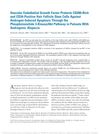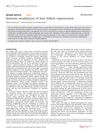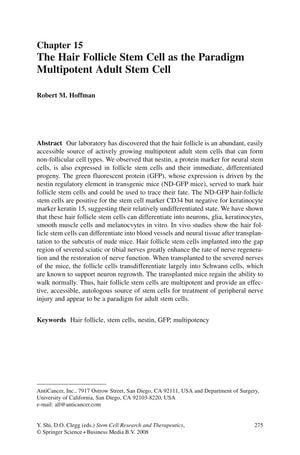TLDR Hair follicle stem cells can turn into many cell types and may help repair nerve damage and have other medical uses.
In the 2008 study, Robert M. Hoffman demonstrated that hair follicle stem cells (HFSCs) are a multipotent and accessible source of adult stem cells, capable of differentiating into a variety of cell types such as neurons, glia, keratinocytes, smooth muscle cells, and melanocytes. These cells, identifiable by CD34 and nestin expression but not keratin 15, were able to form blood vessels and neural tissue in vivo and promote nerve regeneration and functional recovery when transplanted into severed peripheral nerves in nude mice, primarily differentiating into Schwann cells. This research suggests that HFSCs could be a valuable autologous stem cell source for peripheral nerve injury treatment and potentially for broader regenerative medicine applications.
 829 citations
,
May 2007 in “Nature”
829 citations
,
May 2007 in “Nature” Hair follicles can regrow in wounded adult mouse skin using a process like embryo development.
344 citations
,
June 2006 in “American Journal Of Pathology” 319 citations
,
November 2005 in “Proceedings of the National Academy of Sciences” Hair follicle stem cells can help repair damaged nerves.
1279 citations
,
November 2005 in “Nature Medicine” 419 citations
,
March 2005 in “Proceedings of the National Academy of Sciences” Hair-follicle stem cells can become neurons.
212 citations
,
August 2004 in “Proceedings of the National Academy of Sciences” Hair follicle cells can create new blood vessels in the skin.
268 citations
,
December 2003 in “Experimental Dermatology” Hair follicle cells can become fat and bone cells.
387 citations
,
November 2003 in “Journal of Investigative Dermatology” The K15 promoter effectively targets stem cells in the hair follicle bulge.
352 citations
,
August 2003 in “Proceedings of the National Academy of Sciences” Nestin is found in hair follicle progenitor cells, linking them to neural stem cells.
561 citations
,
April 2003 in “Journal of Investigative Dermatology” CD34 is a marker for isolating stem-like cells in mouse hair follicles.
949 citations
,
January 2001 in “Cell” Adult mouse skin contains stem cells that can create new hair, skin, and oil glands.
1010 citations
,
August 2000 in “Cell” Hair follicle stem cells can form both hair follicles and skin.
198 citations
,
March 1999 in “Journal of Investigative Dermatology”
 11 citations
,
September 2019 in “Dermatologic Surgery”
11 citations
,
September 2019 in “Dermatologic Surgery” A substance called Vascular Endothelial Growth Factor can protect certain hair follicle stem cells from damage caused by androgens, suggesting a new possible treatment for hair loss.
 29 citations
,
May 2020 in “npj Regenerative Medicine”
29 citations
,
May 2020 in “npj Regenerative Medicine” Immune cells help regulate hair growth, and better understanding this can improve hair loss treatments.
10 citations
,
October 2019 in “Iranian Biomedical Journal” Simvastatin helps hair follicle stem cells turn into skin cells.
25 citations
,
January 2015 in “World journal of stem cells” Hair follicle stem cells can become different cell types and may help treat neurodegenerative disorders.
 25 citations
,
April 2021 in “The EMBO Journal”
25 citations
,
April 2021 in “The EMBO Journal” Hair follicle stem cells help maintain skin health and could improve skin replacement therapies.






